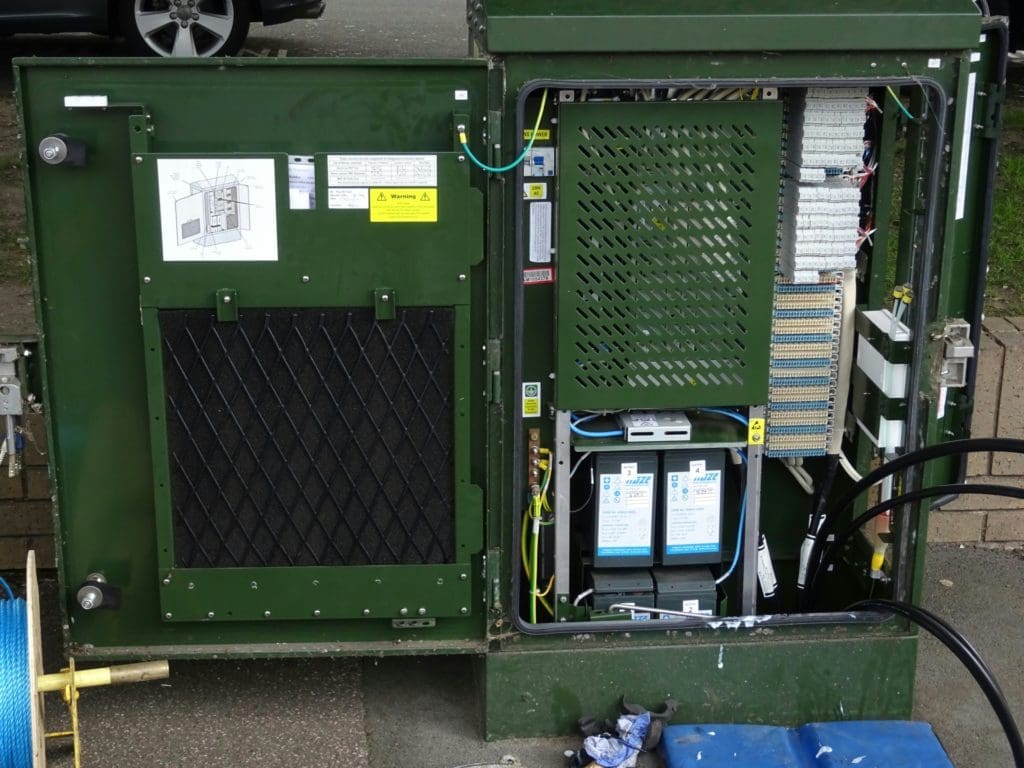Why the UK PSTN switch off matters to EVERYONE
There is a comfort in being tethered. Knowing there is a physical connection between us and our environment keeps us safe and secure. Being grounded often comes with reduced mobility for good reason – seatbelts and harnesses are there to keep us safe and, for a long time, the physical phone line gave us a similar feeling of security.
I can see and touch it, so I have control over it.
However, telecoms users with telephone services like ISDN and traditional phone lines are far from in control. In a car sinking under water, being restrained by a seatbelt would only make the situation worse for the passenger as the environment can’t be controlled. External factors can also make traditional telephony fraught with danger, although thankfully not often life-threatening.
Consider the “landline” telephone – simple to use, but few understand how it works; nor should they have to. Historically, the technology employed was similar to the direct transmission of audio between a microphone and an amplified speaker – largely, if not entirely, analogue.
However, as populations grew and computing became dominant in the home and workplace, two enemies were pitted against the Telco; density and bandwidth. These factors would necessitate innovation and investment in ways not seen since the inception of the national electric grid.

Density – that is the number of lines, customers and ultimately users that could be squeezed into a finite area for cabling and interconnection. There was only so much space in cabinets and telephone exchanges to accommodate metallic cables that often ran for many miles before even reaching the technology that could handle telephone calls, also known as the “switch”. Hence, the Public “Switched” Telephone Network. Multiplexing, or the ability to join many streams of communication together in a more efficient and compact stream, could only go so far with the physical space limitations of metal wiring converging in a bottleneck and the expanding amount of transmission technology involved
Bandwidth – which could be thought of as the capacity to send and receive information, was (and often still is) a limiting factor. Initially, equipment connected to phone lines was really only able to handle audible sounds, that is, what the human ear and brain can understand. This of course made sense historically – why would you want to process information that cannot be spoken or heard in a time of basic voice communication? This is the reason why early data transmission technologies like fax and dial-up internet produced those shrill tones and slurred beeps that we often associate with the dawn of the internet. Bulletin Boards, AOL and Freeserve, to name but a few, all utilised old, underlying transmission technology to create new services. Dial-up internet really was one of the early “over the top” services.
Just like the increasing demand for water as populations grew, the evolving internet needed a bigger “pipe” to send and receive more data. You could spend years, as I initially did, learning about DMT (Discrete Multi-Tone) and QAM (Quadrature Amplitude Modulation), which all contributed to making the data “pipe” traversing those simple, old metallic wires bigger and faster flowing. However, it is probably enough to say that the range of those audible transmission tones of the 1990s and early 2000s were not going to be able to cope with the deluge of data from high quality streaming video, multiplayer gaming and other consumer internet services.
ADSL (Asynchronous Digital Subscriber Line) came along in the early 2000s and initially provided around 10x the capacity of the increasingly popular “dial-up” internet connection. Plus, because it communicated in a higher and wider frequency range inaudible to humans, you could make a phone call on the same telephone line that provided the internet connection simultaneously and without interrupting either experience. Of course, ISDN (Integrated Services Digital Network) was available as an interim “digital” solution to boost internet speeds, but at a cost that could only be bourne by businesses or more affluent members of the public.

As always, the old problems of bandwidth and density got in the way of innovation. ADSL in the early days was problematic, to say the least. Metal wires from 50 or more years ago were being expected to support a technology that wasn’t even imagined when those cables were first fed through underground trenches or carried on telephone poles. In many cases, these cables coped well, but the hype of fast internet access placed a burden on networks and engineers resulting in a lot of customer dissatisfaction.
I was an engineer when ADSL and VoIP (Voice over Internet Protocol) were starting to be deployed together into live business and “prosumer” environments. The promise of multiple simultaneous phone calls sharing bandwidth with other internet applications for a tenth of the price of legacy technology was tempting enough for many to take the risk and sometimes regret it. These early, traumatic days of Internet Telephony were one of the reasons why we still have the old, reliable PSTN today.
It’s hard to believe in the age of Microsoft Teams, Google Apps and Skype that some businesses and individuals still don’t trust VoIP and insist on backing up with, or even preferring, traditional PSTN services above Internet-based technologies. Many have an axe to grind after their early experiences with IP communications, some may be considered Luddites, but many are simply caught in long-term leasing contracts from unscrupulous providers that financially prohibit switching to cheaper, modern communications.
Back to the wires – the great advantage of metallic cabling was also its downfall. The ability to conduct electricity, which ultimately is what the internet was being converted into on those telephone lines, meant that you could transmit almost any data across a cable that might have been as old as the first telephones. Being an incredibly long piece of metal also meant acting like a huge aerial receiver, picking up interference from radio transmissions and other sources of EMI (Electro-Magnetic Interference). In addition, another great conductor, water, could unintentionally cause those data-encoding electrical signals to disappear into places they shouldn’t through leaky seals and degraded cable shielding. The longer the cable, the more chances for disruption to occur along its path.

The transmission of electricity along the telephone network also meant that early consumer telephones didn’t need a separate power supply. In fact, the telephone network of today is also a very low-powered national grid, meaning that the small amount of power required to operate a basic phone handset and amplify the voice of a caller to be heard was actually provided from the telephone exchange. However, the cost and waste of this capability has long overshadowed the benefit of not needing to plug an old-fashioned telephone into the mains power supply. More on this later.
ADSL also got faster and more reliable as a technology, but cable-related interference regularly got in the way of high speeds. As well as EMI, longer cables couldn’t cope with some of the frequencies that carried data transmissions due to a phenomenon known as “attenuation”. There are detailed scientific explanations about how this works, but for our purposes here, it is really the loss of signal power. Cables that handle lower frequencies adequately don’t fare so well with higher frequencies. Faster internet speeds meant a larger and “clearer” frequency range was required for data transmission, i.e. a broader bandwidth. At longer distances, attenuation was a bigger problem and resulted in more signal loss at certain frequency ranges required to increase internet speed.

For many years, people talked about “moving closer to the telephone exchange”, for this reason. Shorter cables meant faster potential speeds. However not everyone can move close to a telephone exchange, so eventually, the exchange would move closer to them!
Miniaturised versions of exchange equipment, called DSLAMs (Digital Subscriber Line Access Multiplexer) would be installed into new, more secure street cabinets – those green boxes that you often see Openreach engineers working on. That meant the cable length from the home or business to the equipment that would ultimately connect them to their Service Provider’s network was dramatically reduced. It also meant that few cables from individual premises needed to be separately run all the way back to the exchange.
The era of 38 and then 78Mbps FTTC broadband had arrived – Fibre to the Cabinet.
FTTC is however yet another evolutionary step along the path to even greater bandwidth, as FTTP (Fibre to the Premises) delivers speeds of 1Gbps and beyond by removing metal cables entirely from the network, right up to the house or business, where often WiFi or local high-speed cabling takes over. Without metal cables, “useful” electricity cannot be transmitted to those old, unpowered phones, but the benefits of not conducting interference mean that fibre is far superior for data transmission.

As the UK now has fixed line and mobile internet access with greater speed and reliability than we’ve ever known, the market for VoIP in its many forms has matured to a level where accessibility is almost ubiquitous.
Microsoft Teams, Skype, Zoom, Whatsapp, Telegram and many other Unified Communications (UC) services work from almost anywhere in the UK on almost any modern communication device, so businesses and the general public can finally be unhooked from the (traditional) line.
So, why do we still have a legacy telephone network like the PSTN and what are the risks of keeping it running?
Environmental – imagine owning two ovens and heating up half your dinner in one and the other half in the other. Ok, maybe not the most accurate analogy, but it does give you an idea of the potential waste of running two networks simultaneously. Switching off the old network, which by today’s standards is nowhere near as efficient as the current one, represents a reduction in energy consumption that will have a positive impact on carbon emissions.
Cost – but why would you want to save BT (and similar operators) money? When it comes to setting prices for today’s voice and data services or investing in better and faster technologies, a reduction in operational cost potentially unlocks savings that could be better utilised for the consumer or business user. A lot of countries haven’t had to keep maintaining and investing in legacy equipment, and associated technical debt as the UK has, so have been able to move much faster towards universal Gigabit access as a result.
Emergencies – believe it or not, one of the obstacles to switching off the PSTN is that electricity would no longer be provided on the phone line to power those old-fashioned telephone handsets that don’t use mains power, rendering them useless. A number of users with these devices who refuse to change them may not be able to contact emergency services at the time of “switch-off”. Although with the low cost of basic mobile phones and service contracts, I would argue that having a device that can travel room to room and not rely on any cables (if charged) is significantly safer than a piece of century-old technology tethered to the closest telephone wall socket. Solutions being proposed and in some cases enforced by regulators include incredibly providing a battery to continue to power these devices, at the expense of the telecoms operator and ultimately the average consumer.
Capacity – if you’ve ever visited a telephone exchange, you will have seen and heard row upon row of boxes clicking and whirring as they ceaselessly connect callers to each other while attempting to keep cool in an increasingly overcrowded room. This space could surely be put to better use by housing faster, more compact technology, using less power and freeing up space for business or even residential real estate. Imagine tech-business hubs popping up in offices converted from telephone exchange rooms where gigantic pieces of archaic network equipment once ruled.
Innovation – while old technology is left in widespread use, an imbalance and unfairness is left to fester in society and the economy. Businesses that don’t, by choice or necessity, adopt newer technologies will be left behind in an internet-centric world. There are times when adoption strategy needs to be shifted from encouragement to enforcement for the good of the unwitting benefactor, be that business or consumer. It doesn’t benefit anyone if outdated technology starts to affect business performance or user experience, which are often tightly coupled.
The PSTN switch-off won’t change physics, however. Metallic cables will still behave in the same way, electromagnetic interference will still be generated and many “xDSL” services will remain slow or unreliable due to line length. The majority of decades-old tech will not disappear overnight when the “switch off” happens. However, if we see this change as part of a wider transformation programme, with savings and innovation investment attached, it’s clear that evolution requires a lot of direct and indirect contributions to succeed.

There is often tension and sometimes intransigence when technology evolves, but as an industry, we must do a better job of alleviating concerns and dispelling myths about the negative aspects of these advances. Problems stop being seen as such with a small amount of market education, encouraging more organisations to make sensible and forward-looking choices when deploying technology solutions.
Many who read this article may question the simplification of technical information and some of the analogies included, but I would rather consider this a venture to improve information accessibility. While the Telecoms and IT industries are extremely talented at marketing to their peers and other experts, they are often not so attuned to the level of understanding of the general public or average business user.
Consumers, business users, service providers and the national economy will benefit if we make “Educational Marketing” a priority in the time remaining until the PSTN says its final farewell. If this is something that you would like help with to achieve for your business and your customers, please get in touch.
Tim Meredith
Hi! I'm Tim Meredith, CEO at Fractional Teams. I write about the latest industry insights and give advice on Unified Comms development and growth.
